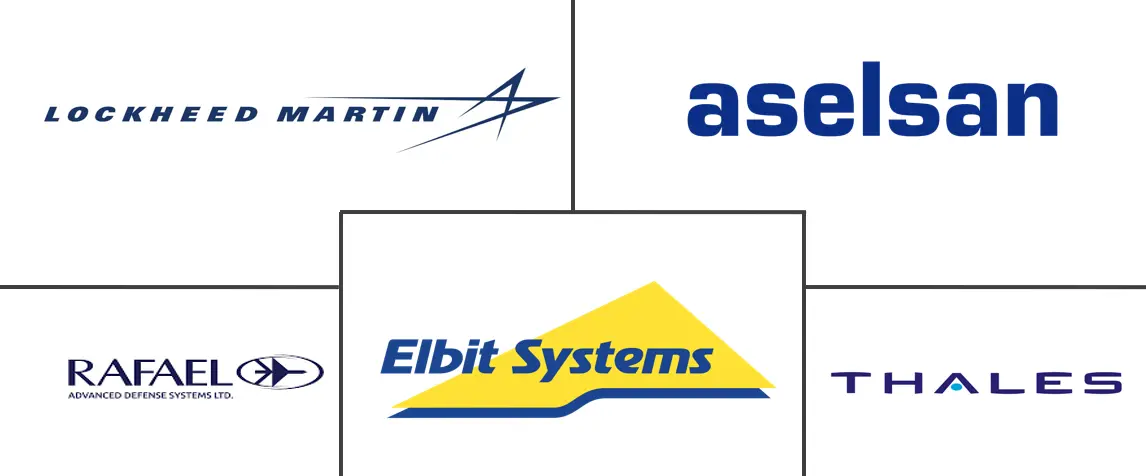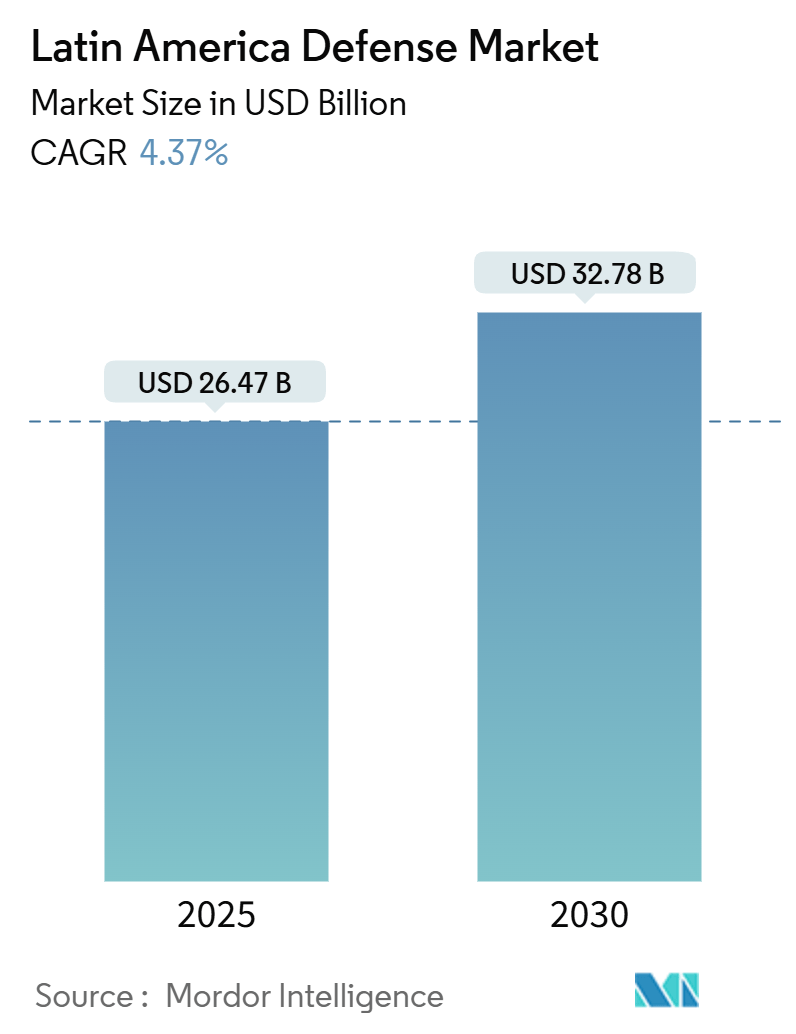
Latin America Defense Market Analysis by Mordor Intelligence
The Latin America Defense Market size is estimated at USD 26.47 billion in 2025, and is expected to reach USD 32.78 billion by 2030, at a CAGR of 4.37% during the forecast period (2025-2030).
A mix of established global defense contractors and emerging local firms characterizes the Latin American defense market. This market encompasses various products, including aircraft, naval vessels, armored vehicles, and cybersecurity systems. In 2023, military expenditures reached USD 62.48 billion, and projections indicate steady growth driven by modernization efforts and regional security challenges.
Many Latin American nations are modernizing their military capabilities to address conventional and asymmetrical threats. Notably, Brazil and Colombia are making significant investments to upgrade their air and naval fleets, incorporating advanced technologies such as UAVs and network-centric warfare systems. Countries like Chile and Brazil strongly emphasize naval enhancements due to their extensive maritime borders. Brazil's PROSUB program (Submarine Development Program), which aims to bolster its submarine fleet, is a testament to this. This program includes the notable construction of the nuclear-powered submarine Alvaro Alberto.
Cybersecurity has become a paramount concern as military operations become increasingly digitized. In response, nations are enhancing their cyber defenses through strategic investments and collaborations with global tech firms. Furthermore, integrating AI, machine learning, and data analytics into defense systems is reshaping operational strategies and bolstering advantages in intelligence, surveillance, and reconnaissance (ISR) capabilities.
Latin America Defense Market Trends and Insights
Air Force to Account for Largest Market Share During the Forecast Period
Heightened investments in advanced fighter jets, surveillance drones, and missile defense systems underscore the region's emphasis on air dominance and strategic aerial capabilities, granting the Air Force segment a significant market share. Rising geopolitical tensions drive defense budgets, leading to increased procurement and modernization of military aircraft and helicopters, marking a notable transformation in the Air Force segment.
As of December 2023, Brazil's Air Force boasts an active fleet of 448 military aircraft and 29 helicopters. Mexico's Air Force operates 268 aircraft and 118 helicopters; Chile's has 153 aircraft and 29 helicopters; Argentina's fields 101 aircraft and 26 helicopters; and Colombia's Air Force has 135 aircraft and 137 helicopters. Countries with operational fleets are ramping up maintenance and repair efforts to ensure peak reliability and readiness, driving heightened demand in the industry. For instance, in June 2023, Embraer secured a contract with the Brazilian Air Force for a midlife upgrade program on the A-29 Super Tucano aircraft, ensuring its operational capabilities and lifespan enhancements.
Peru has also unveiled a significant enhancement to its air defense system, committing to the purchase of 24 advanced fighter jets at a cost of USD 3.5 billion in October 2024. This acquisition represents the first major renewal of Peru's combat aircraft fleet in nearly three decades.
In the Latin American defense market, especially among air forces, there's a notable uptick in the demand for Unmanned Aerial Vehicles (UAVs). This surge is primarily due to the increasing need for surveillance, reconnaissance, and combat capabilities. Countries across the region are investing in UAVs to bolster defenses against threats like drug trafficking, illegal fishing, and border security challenges, drawn by their versatility and cost-effectiveness.
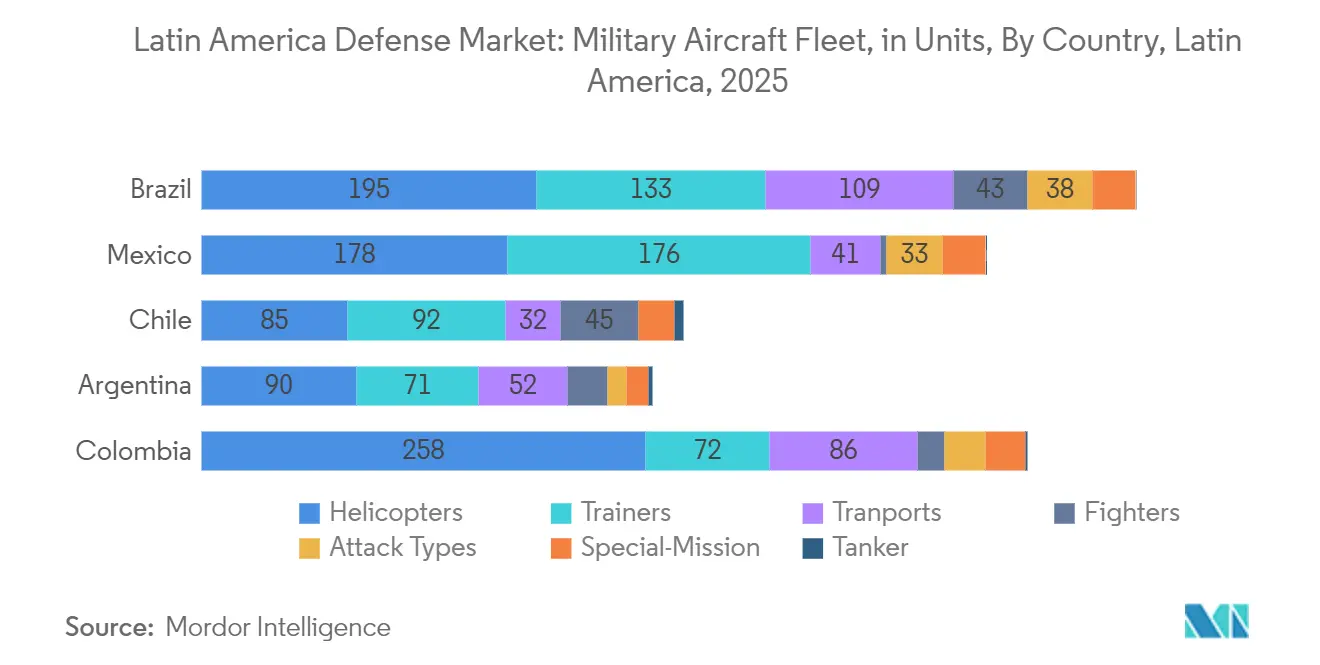
Brazil to Witness Fastest Growth During the Forecast Period
Brazil's defense market is rapidly expanding, driven by escalating security challenges, notable increases in defense budgets, investments in UAV and cybersecurity technologies, and enhanced military infrastructure through international collaborations and modernization efforts. In 2023, Brazil allocated around USD 22.9 billion to its military, a 3% increase from the USD 20 billion spent in 2022. This rise in military expenditure is linked to growing crime rates, narcotrafficking at borders, illegal mining, smuggling, and tensions with neighboring countries such as Argentina and Uruguay.
The augmented budget bolsters border security, enhances surveillance and intelligence capabilities, and fortifies defense infrastructure. Brazil's defense, security, and aviation sectors are pivotal in the Southern Hemisphere, essential for regional stability and addressing diverse security challenges. With one of the region's most capable armed forces, Brazil aims to amplify its power-projection abilities, intensify surveillance over the Amazon and coastal waters, and advance its defense industry.
Furthermore, Brazil is modernizing its military platforms and large-caliber weapons to strengthen its armed forces. In August 2023, the Brazilian government unveiled plans to channel BRL 52.8 billion (equivalent to USD 10.6 billion) into military research, development, and equipment procurement. This investment will see Brazil nearly doubling its Gripen fighter fleet and backing projects from local aircraft manufacturer Embraer, specifically for aerial refueling planes.
Under the new PAC, the Brazilian Air Force emphasizes the renewal of its fighter aviation fleet, spearheaded by the Gripen fighter acquisition. Brazil intends to order four additional Saab-Embraer F-39E jets in addition to the 36 already secured and is contemplating another batch of at least 30 F-39E fighters. Such developments will drive the market across the country.
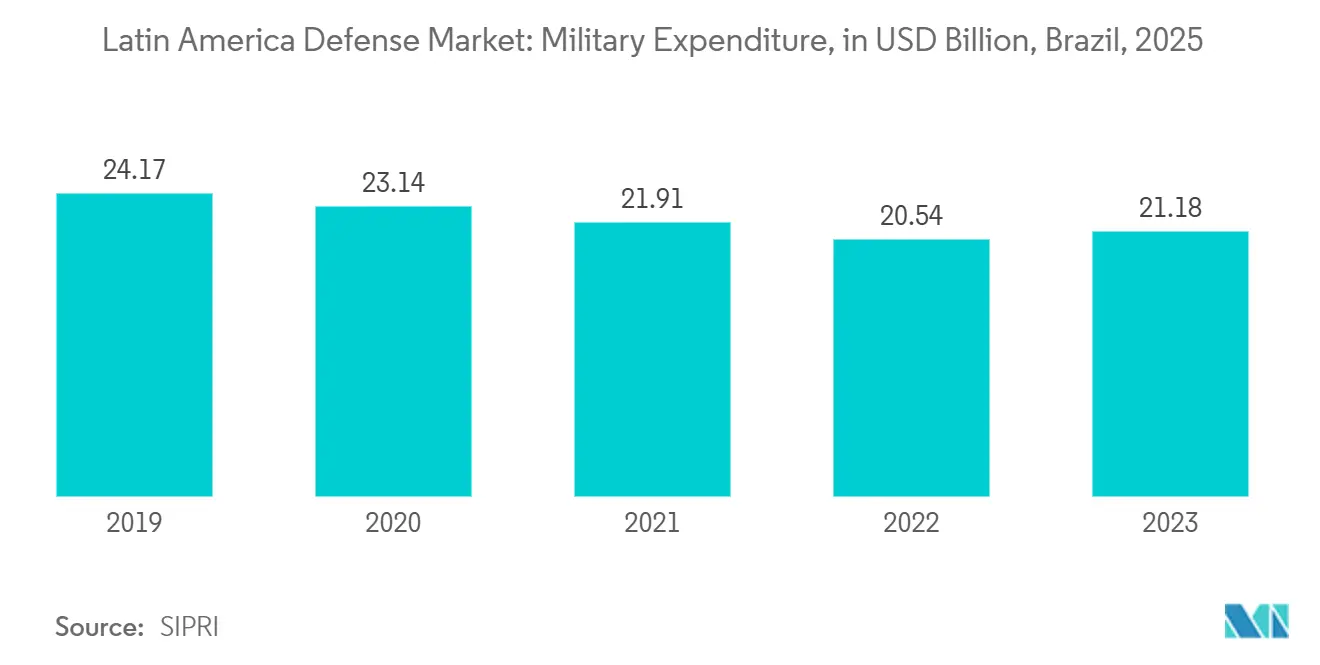
Competitive Landscape
The Latin American defense market remains fragmented. Key players include RAFAEL Advanced Defense Systems Ltd., Elbit Systems Ltd., ASELSAN A.S., THALES, and Lockheed Martin Corporation. The region has numerous local players, many state-owned, and serve only their domestic armed and security forces. Noteworthy examples include Compañía Anonima Venezolana de Industrias Militares (CAVIM) in Venezuela, Fábrica de Armas y Municiones del Ejército (FAME) in Peru, Fábricas y Maestranzas del Ejército (FAMAE) in Chile, and INDUMIL in Colombia.
Even with a robust local presence, international players, particularly from the US, Germany, and France, maintain a significant foothold in the market through defense equipment imports. Lockheed Martin Corporation emerges as a frontrunner in the LATAM defense landscape. Its subsidiary, Sikorsky, provides military and rotary-wing aircraft to military and commercial sectors.
Companies are also pushing boundaries with innovations to bolster their market share. For instance, in April 2024, FN Herstal, a century-old Belgian firm with deep roots in Latin America, presented its latest firearms in Santiago de Chile. FN Herstal's Latin American journey commenced with FN Mauser rifle sales, later marking milestones with the FN FAL light automatic rifle, FN MAG general-purpose machine gun, and FN GP (High Power) pistol. At the showcase, the company highlighted a variety of small arms, notably the FN HiPer 9mm pistol and the FN EVOLYS ultralight machine gun, both featuring cutting-edge day & night sights.
Latin America Defense Industry Leaders
-
RAFAEL Advanced Defense Systems Ltd.
-
Elbit Systems Ltd.
-
ASELSAN A.S.
-
THALES
-
Lockheed Martin Corporation
- *Disclaimer: Major Players sorted in no particular order
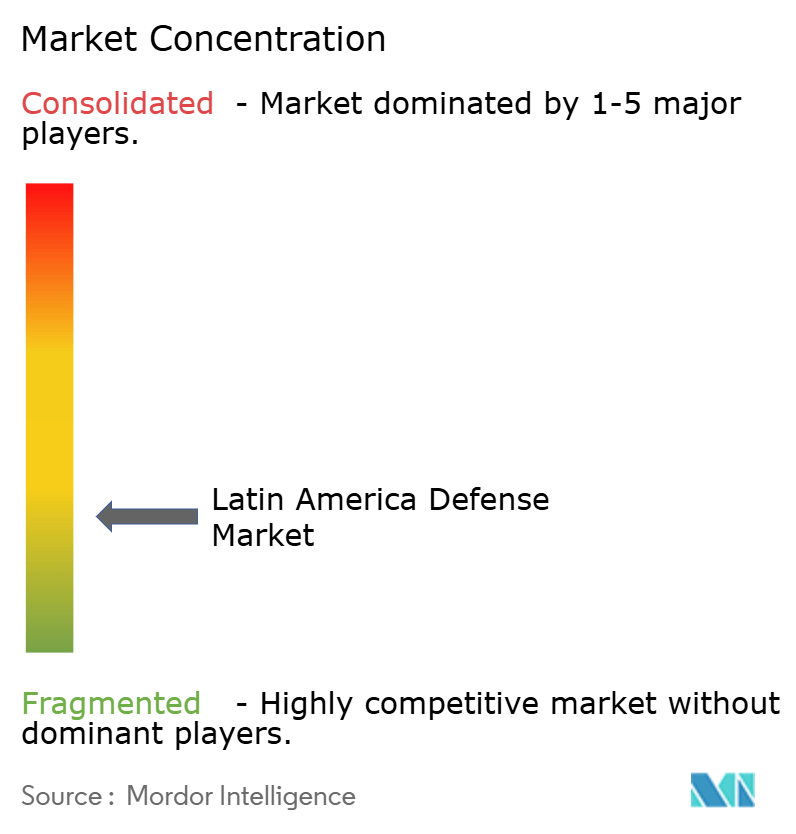
Recent Industry Developments
- July 2024: The Brazilian Army issued a Request for Quotation (RFQ) for eighteen specialized engineering vehicles (VE ENG), explicitly targeting the TATRA T-815 type 7T3R41. If selected, the Brazilian Army intends to integrate the Improved Ribbon Bridge (IRB) and Logistic Support Bridge (LSB) systems into the vehicle, enhancing its mobility for diverse tasks, from crossing water bodies to conducting military operations and providing disaster relief.
- April 2024: Embraer and ENAER (National Aeronautical Company of Chile) announced two collaborative agreements. These agreements pertain to the A-29 Super Tucano, the C-390 Millennium defense aircraft, and a range of commercial aircraft. Through this partnership, Embraer seeks to bolster its supplier and service network in Chile, fostering a closer integration of the aerospace sectors in both Brazil and Chile.
- March 2024: The Peruvian Navy inked a USD 463 million deal with HD Hyundai Heavy Industries (HHI) in a landmark move. The contract encompasses the co-construction of a 3,400-ton frigate, a 2,200-ton Offshore Patrol Vessel (OPV), and two 1,500-ton Landing Craft Units (LCUs), all slated for completion by 2029. Marking the most significant defense agreement for a South Korean firm in Latin America, HHI will join forces with Sima Shipyard, a local Peruvian shipyard, for this ambitious project.
Latin America Defense Market Report Scope
The Latin American defense market involves procuring, developing, and deploying military equipment, technologies, and services throughout the region. This market encompasses the sale and production of defense assets, including aircraft, naval vessels, armored vehicles, unmanned systems, and cybersecurity solutions. Furthermore, it covers the R&D of advanced defense technologies and military systems' training, maintenance, and upgrades. The market strongly emphasizes strategic partnerships, technology transfers, and regional cooperation with international allies. Influenced by regional security needs, geopolitical dynamics, and economic conditions, the market is pivotal in shaping defense spending and policymaking across Latin America.
The Latin American defense market is segmented by end-user, type, and geography. By end-user, the market is segmented into army, navy, air force, law enforcement, disaster response, and others. The other segments include rescue, coast guard, etc. By type, the market is segmented into armored vehicles, military aircraft and helicopters, naval vessels, ammunition, weapons, radar systems, unmanned systems, protective equipment, and others. The report provides market sizes and forecasts for the defense market in major Latin American countries. For each segment, the market size is provided in terms of value (USD).
| Army |
| Navy |
| Air Force |
| Law Enforcement |
| Disaster Response |
| Others (Rescue, Coast Guards, etc.) |
| Armoured Vehicles |
| Military Aircraft and Helicopters |
| Naval Vessels |
| Ammunition |
| Weapons |
| Radar Systems |
| Unmanned Systems |
| Protective Equipment |
| Others |
| Brazil |
| Mexico |
| Chile |
| Argentina |
| Colombia |
| Rest of Latin America |
| End-User | Army |
| Navy | |
| Air Force | |
| Law Enforcement | |
| Disaster Response | |
| Others (Rescue, Coast Guards, etc.) | |
| Type | Armoured Vehicles |
| Military Aircraft and Helicopters | |
| Naval Vessels | |
| Ammunition | |
| Weapons | |
| Radar Systems | |
| Unmanned Systems | |
| Protective Equipment | |
| Others | |
| Country | Brazil |
| Mexico | |
| Chile | |
| Argentina | |
| Colombia | |
| Rest of Latin America |
Key Questions Answered in the Report
How big is the Latin America Defense Market?
The Latin America Defense Market size is expected to reach USD 26.47 billion in 2025 and grow at a CAGR of 4.37% to reach USD 32.78 billion by 2030.
What is the current Latin America Defense Market size?
In 2025, the Latin America Defense Market size is expected to reach USD 26.47 billion.
Who are the key players in Latin America Defense Market?
RAFAEL Advanced Defense Systems Ltd., Elbit Systems Ltd., ASELSAN A.S., THALES and Lockheed Martin Corporation are the major companies operating in the Latin America Defense Market.
What years does this Latin America Defense Market cover, and what was the market size in 2024?
In 2024, the Latin America Defense Market size was estimated at USD 25.31 billion. The report covers the Latin America Defense Market historical market size for years: 2020, 2021, 2022, 2023 and 2024. The report also forecasts the Latin America Defense Market size for years: 2025, 2026, 2027, 2028, 2029 and 2030.
Page last updated on:
Latin America Defense Market Report
Statistics for the 2025 Latin America Defense market share, size and revenue growth rate, created by Mordor Intelligence™ Industry Reports. Latin America Defense analysis includes a market forecast outlook for 2025 to 2030 and historical overview. Get a sample of this industry analysis as a free report PDF download.
